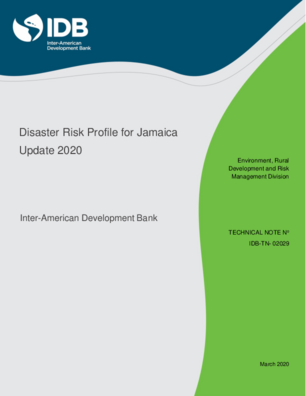Disaster Risk Profile for Jamaica: Update 2020
Date
Mar 2020
One of the key strategic activities of disaster risk management (DRM) at the country or regional level is the assessment of the risk of disaster associated with extreme natural events, which requires the use of reliable methodologies that allow an adequate estimation and quantification of potential losses in a given exposed time. Although there are several international methodologies for detailed risk assessment for different types of natural hazards, few of them allow analysis at the country level for two main reasons: first, there is a lack of detailed information that prevents the formation of a robust database to describe the exposure and, second, there is a lack of an integrated and consistent methodology to assess the probabilistic modelling of different natural hazards, considering simultaneously the vulnerability of the exposed elements and their associated risk.
To achieve the overall goal of identifying and quantifying catastrophic risk, it is necessary to include relevant natural hazards in an integrated manner, considering both their individual intensities and frequencies of occurrence. Moreover, the approach should capture the main features of the information of the exposure model of infrastructure assets and components. These will define for every class of component, its corresponding vulnerability for each one of the hazards considered. The vulnerability representation, together with the hazard, will define the associated risk. The assessment will be undertaken using a consistent probabilistic based model which considers both the hazard intensity distribution and the frequency of occurrence, in addition to their associated uncertainties. The resulting probabilistic risk parameters shall be interpreted considering the defined exposure resolution and the inevitable limitations of the information used, both in terms of quality and completeness.
To achieve the overall goal of identifying and quantifying catastrophic risk, it is necessary to include relevant natural hazards in an integrated manner, considering both their individual intensities and frequencies of occurrence. Moreover, the approach should capture the main features of the information of the exposure model of infrastructure assets and components. These will define for every class of component, its corresponding vulnerability for each one of the hazards considered. The vulnerability representation, together with the hazard, will define the associated risk. The assessment will be undertaken using a consistent probabilistic based model which considers both the hazard intensity distribution and the frequency of occurrence, in addition to their associated uncertainties. The resulting probabilistic risk parameters shall be interpreted considering the defined exposure resolution and the inevitable limitations of the information used, both in terms of quality and completeness.




